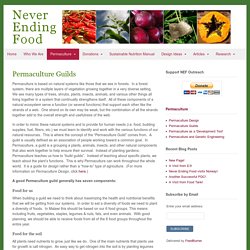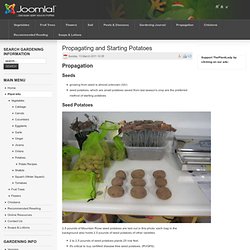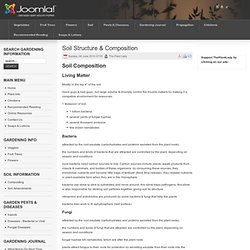

Permaculture Guilds - Never Ending Food. Permaculture is based on natural systems like those that we see in forests.

In a forest system, there are mulitple layers of vegetation growing together in a very diverse setting. We see many types of trees, shrubs, plants, insects, animals, and various other things all living together in a system that continually strengthens itself. All of these components of a natural ecosystem serve a function (or several functions) that support each other like the strands of a web. One strand on its own may be weak, but the combination of all the strands together add to the overall strength and usefulness of the web. In order to mimic these natural systems and to provide for human needs (i.e. food, building supplies, fuel, fibers, etc.) we must learn to identify and work with the various functions of our natural resources.
A good Permaculture guild generally has seven components: Food for us Food for the soil All plants need nutrients to grow, just like we do. Diggers/Miners.
Sustainable Agriculture. Organic Gardening Supplies. Finance. Companion Planting. Water. Homesteading. Temperate Climate Permaculture. Hog Peanut (Amphicarpa bracteata) Permacultureglobal.com - the interactive map and database of the Worldwide Permaculture Network. Multi-Rain Barrel System. I’ve been wanting to build a rain barrel system for a long time!

I wanted something that would store a a large volume of water that can be used in the garden during the long periods without rain. I also wanted to build it in a way that it’s expandable. In other words, I wanted to add to it over time to make it larger for storing more water for even longer dry spells. Here’s what I came up with: Dual Rain Barrel It’s a simple two-barrel system with PVC plumbing. Here are the details for building the system: I began the project by selecting a location. Cinder Blocks stacked for Rain Barrels Once I decided on this location, I leveled the ground where the barrels will be placed.
Leveled ground for rain barrels I placed the blocks in a triangular configuration so that the most contact was maintained between the barrels and the blocks. Next, I acquired the plumbing fittings I chose to use. Here are the parts for the inside of the barrel to act as a drain.
Mushrooms. Propagating and Starting Potatoes. Sunday, 13 March 2011 10:35 Seeds growing from seed is almost unknown (GV) seed potatoes, which are small potatoes saved from last season's crop are the preferred method of starting potatoes Seed Potatoes 2.5 pounds of Mountain Rose seed potatoes are laid out in this photo; each bag in the background also holds 2.5 pounds of seed potatoes of other varieties 2 to 2.5 pounds of seed potatoes plants 25 row feet. it's critical to buy certified disease-free seed potatoes.

(RVGPS) the flesh of the seed potato is the food that will fuel the plant growth for up to 3-weeks (RVGPS) tubers left in the ground will often sprout the next year, however this isn't advisable, as they tend to become diseased. Chitting 2.5 pounds of Mountain Rose and 2.5 pounds of German Butterball seed potatoes laid out for chitting Note: I shouldn't have cut them before chitting them. Chitting seed potatoes shortens the time between planting and harvesting. M.Fukuoka.
Home : Field & Forest, Proud to be part of this rotting world! The Plant Lady. Soil Structure & Composition. Sunday, 06 June 2010 07:35 The Plant Lady Living Matter Mostly in the top 4" of the soil.

Good guys & bad guys...but large volume & diversity control the trouble makers by making it a competive environment for resources. 1 teaspoon of soil: 1 billion bacteria several yards of fungal hyphae several thousand protozoa few dozen nematodes Bacteria attracted by the root exudate (carbohydrates and proteins secreted from the plant roots). the numbers and kinds of bacteria that are attracted are controlled by the plant, depending on season and conditions most bacteria need carbon sources to live. Bacteria use slime to stick to substrates and move around. this slime traps pathogens. this slime is also responsible for sticking soil particles together, giving soil its structure. vitmamins and antiobiotics are produced by some bacteria & fungi that help the plants bacteria also work in th ephyllosphere (leaf surface) Fungi fungal hyphae kill nematodes, which are after the plant roots Protozoa Nematodes earthworms. Milkwood: permaculture farming and living.
Permacultiver. Practical Plants. Polycultures, Guilds & Companions...

In addition to each plant being able to record interactions with other individual plants, users can also create polycultures or guilds of known plant combinations that work well together. We are at the very start of our collection of polycultures with The Three Sisters set up as a quick example. You can create your own favourite polycultures here: An open encyclopedia of plant information There are plenty of sources of plant information online.
It belongs to all of us Everything is editable by anybody, and licensed under a Creative Commons license to be used by anybody. A specific focus for a broad audience It's simple: if a plant has practical uses, inform how to propagate, cultivate, and use it. It's practical Covering edible, material and medicinal uses, design functions, propagation, cultivation, environmental preferences, interactions, polycultures (and so on...)